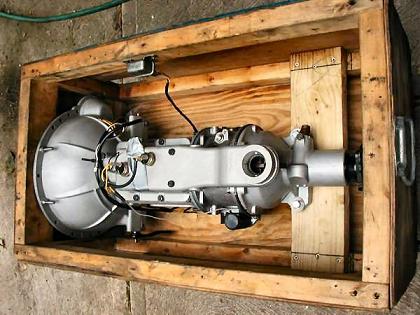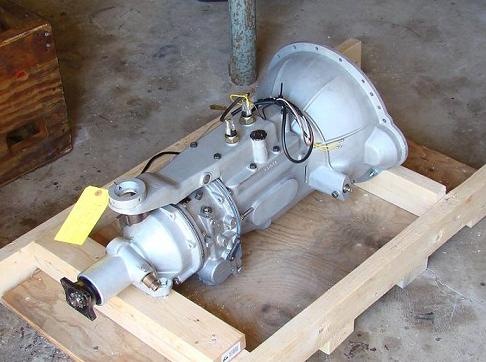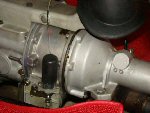

In 2009, I purchased a rebuilt transmission with overdrive from master builder Ed Woods of Pittsburgh. Ed also rebuilt my engine and carbs. The new transmission arrived nicely and carefully crated with Isolator switches and solenoid already assembled and wired.
 |
 |
In a two man operation, the transmissions were swapped with front end of car jacked up and supported by adjustable car jack stands. The relay was installed under the dash and a typical pear shapped operating switch was mounted on the dash. Click Picture To Enlarge.
 |
 |
 |
 |
 |
Original Transmission |
Disconnected From Drive Shaft |
New Transmission |
Showing Solenoid |
Solenoid Closeup |
 |
 |
|||
Pear Shaped Dash Switch |
Finished and Buttoned Up |
F |
The solenoid valve system was adjusted per instructions from Ed Woods. They are repeated here since these instructions seem much more simple than those found in the Service Manual.
There are two coils within the solenoid: a high current, hi tork and a low current, lo tork. Both are used to pull the plunger in, at which time an internal switch is tripped which opens the hi tork coil, leaving only the lo tork coil to "hold" the solenoid in. If this switch is not tripped, current continues to flow thru both coils, smoking the hi tork coil. An ammeter with the o/d connected to the load side will show 20 or 30 amps for both coils, 2 amps for the lo tork coil. If the solenoid is improperly adjusted, you will see high current in time to turn the o/d off and save the solenoid. That's why I want you to have a working ammeter.
You do not need a dial indicator to adjust the solenoid.
1. With the solenoid clamp bolt loose, road test the car with a helper in the passenger seat. Be very careful as the drive shaft is only a coat tail away. Have your passenger manually engage the OD by moving the "Valve Setting Lever" on the right side of the transmission until the OD engages. Note/mark the position of the lever
2. Back in your garage, with the solenoid clamp bolt loose, energize the solenoid in the normal manner: ignition on, dash switch on, gearbox in an overdrive gear.
3. Move the lever on the right to the working position you found when you road tested the o/d. Hold it there.
4. Move the solenoid lever fully down against the bottom of the plunger.
5. Tighten the clamping bolt without moving either lever.
6. Turn the o/d switch off and on. Monitor the ammeter. Monitor the r/h lever. The ammeter should read 1 or 2 amps (almost zero) and the lever should move to the position you found when you road tested it successfully.
7. If you pass the tests in instuction 5., road test the o/d using the dash switch. If not, repeat steps 1-6 till you get it right.
REMEMBER: THE O/D WILL OPERATE MOST SMOOTHLY IF YOU KEEP POWER ON WHILE SHIFTING EITHER UP OR DOWN. DO NOT TAKE YOUR FOOT OFF THE GAS. PRACTICE. IT SHOULD OPERATE AS SMOOTHLY AS AN AUTOMATIC TRANSMISSION.
The above instructions were carefully followed but the OD would either not engage with dash switch or when it did it would not disengage. When that happened the car could not be moved in reverse. The process of adjusting continued for weeks with correspondence and new "try this" from Ed Woods. We managed to get the OD to work all the time, but it would still not disengage. Sometimes we could disengage by rapping on side of OD with a rubber hammer, but most often we had to let the car sit for several hours until the hydraulics "bled" out enough to cause the clutch to disengage.
Finally Ed drove from Pittsburgh to my home (3.5 hours) to look at the problem for himself. After a few hours of maniuplation and driving, Ed shook his head and said this was the first transmission he had rebuilt in 40 years that had failed. He drove back to Pittsburgh and said he would build me another transmission. I drove the car without the OD electrically connected for the remainder of the summer. I finally got tired of seeing my life and the ground flash before my eyes from the fast turning drive shaft and did not appreciate the heat from the exhaust pipe that would have made the car comfortable in the winter......So I put on the transmission tunnel with a couple of screws.
To add insult to injury, at some point in this frustrating experience, we noticed the cooling fan had lots of slop. This led to taking off the front end of the car and replacing the "keys" on the crankshaft. The car threrefore lived in my garage for the still drivable Fall months until May when that job was done and the saga of electrical problems began (See "Seeking a Ground").
With the fan problem resolved, I drove the car for several months this summer (2010) and received pictures from Ed showing the progress of the rebuild of a new transmission. Ed was within a week or so of shipping that new transmission when I received an e-mail. He said for the second time in 40 years another one of his OD transmissions failed. He had built one for a TR4 several years ago but the fellow had just installed this summer. He was having the same problems I experienced. The OD would engage, but not electrically disengage.
A few days later I received another message that the TR4 owner (Jay Galbreath) had found an article in a Healey Magazine discussing the same problem. The "solution" was the use of a synthetic oil called MT-90 Red Line, an SAE 75W90 Manual Transmission/Transaxle Oil. Jay replaced his 30 wt oil with the MT-90 and his OD worked with no problems. Ed and Jay posted this information on a Triumph Page and had 4 responses from owners who said the synthetic oil also solved their OD problem.
Ed sent me two quarts of the $11 per oil and I exchanged fluids. Since I do not have a lift, I have the black and blue arms to prove that I contorted my arms between the floor pan and the transmission to remove and replace the two drain plugs. I was hopeful, but not optomistic as I made a road test. UREA! IT WORKED! So far, I have been driving the without an OD glitch. I still can't believe such a simple solution solved the problem. Now that I am driving my "3" with OD, I do not want to be without one. It makes driving even more enjoyable.